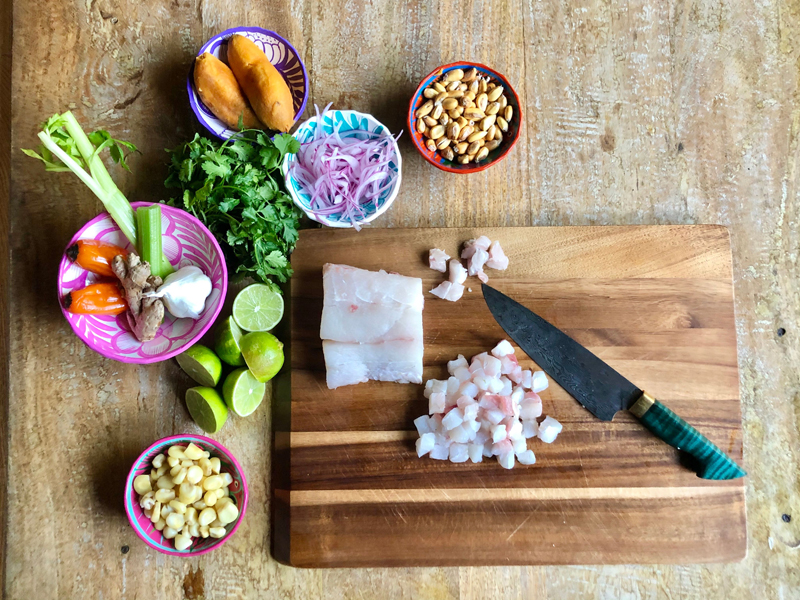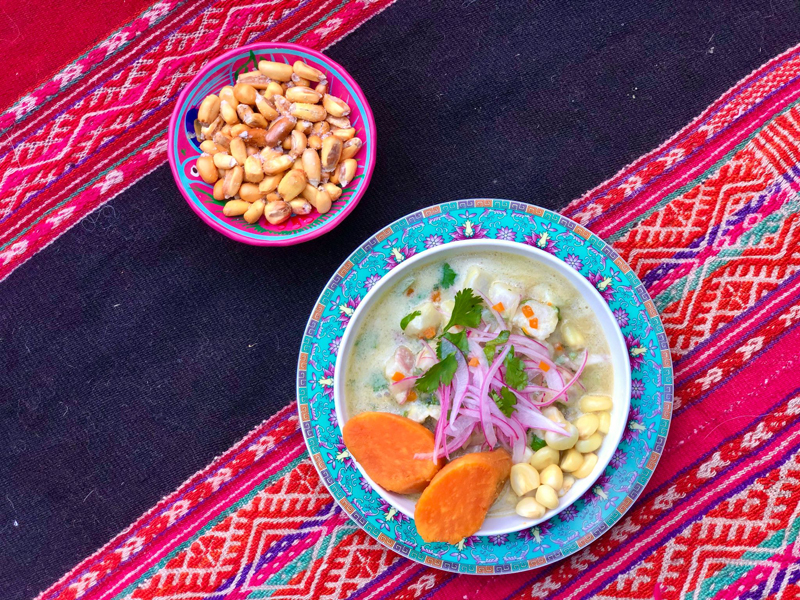PHOTOS BY CHRISTINA NGUYEN
Christina Nguyen is the chef-owner of restaurants Hai Hai and Hola Arepa in Minneapolis and a 2019 James Beard award finalist for Best Chef: Midwest. Open Ticket presents some of Chef Nguyen’s favorite culinary discoveries and inspirations from around the world.
There are only a few dishes in my life that I’ve loved so much that I have changed my plans for them. Peruvian ceviche (or cebiche) was a dish that made me want to slow down, settle in, and put down roots in Lima the first time I tried it. It was probably a combination of access to fresh seafood, summer weather in February, and the enticing pull of culturally-rich neighborhoods like Miraflores and Barranco that begged to be explored.
It also helped that Lima is obscenely affordable for how great of a destination it is, a perfect place for a couple of food-driven budget travelers like ourselves. What’s the hurry? Why leave? What started as a few days’ stop in the capital city while backpacking through Peru in 2012, turned into three weeks of exploring Lima’s unique food scene and indulging in fresh-caught seafood in its many forms every single day. There were also more than a few pisco sours, yoga classes, a park full of abandoned cats to play with, and an exceedingly creepy Inquisition Museum to bide our time in between much anticipated meals.
 Ceviche originated in Peru, where it’s the national dish. Raw cubed or sliced fish is marinated in lime juice, onion, chili, and salt. A good ceviche is simple and all about striking the perfect balance between acid, fat, and texture. JuanMa Calderón, the chef and co-owner of Celeste, a lauded Peruvian restaurant in Boston, says of ceviche: “It’s so simple that you are on the same level to do something wrong or do something super. The balance has to be the perfect balance. It’s not only the ingredients. Maybe you need the hand, maybe you need the heart. There are a lot of things that need to be in total balance.”
Ceviche originated in Peru, where it’s the national dish. Raw cubed or sliced fish is marinated in lime juice, onion, chili, and salt. A good ceviche is simple and all about striking the perfect balance between acid, fat, and texture. JuanMa Calderón, the chef and co-owner of Celeste, a lauded Peruvian restaurant in Boston, says of ceviche: “It’s so simple that you are on the same level to do something wrong or do something super. The balance has to be the perfect balance. It’s not only the ingredients. Maybe you need the hand, maybe you need the heart. There are a lot of things that need to be in total balance.”
Oftentimes, Mexican ceviches are served with tostadas to add texture and balance the sharp tanginess of the lime juice. Peruvian ceviche balances its acidity with garnishes of creamy sweet potato, choclo (large, starchy corn kernels popular in Andean cuisine) and cancha (toasted crunchy corn nuts). Another key ingredient that is near impossible to find in its fresh form in the US is ajíamarillo,the yellow chile pepper that is ubiquitous in Peruvian cuisine.
“El ají is the most important ingredient to me. Ajíamarillo is the base for everything in Peruvian cuisine and it’s basically in every single plate,” says Chef Calderón. The importance of ají cannot be overstated. From the cookbook Cocina Peruana: “For Peruvian cuisine, the ají pepper represents a huge paradox. Using the right amount and in the correct recipe, it can lift our cuisine to the heights of international recognition. However, if its fiery spice makes it to the feasting table, our cuisine suffers and becomes bankrupt.”*
Last but not least, the treasured pot of gold at the end of the ceviche rainbow is Leche de Tigre or “tiger’s milk” which is said to be an aphrodisiac or hangover cure. This is the leftover liquid that the ceviche has marinated in that can be oftentimes ordered separately on a menu as a shot and drank on its own. To concentrate the flavor of the leche de tigre and make it truly quaffable, Chef Calderón makes a “salsa madre” of lime, oil, ginger, celery, onions, garlic and ají pepper that is blended into a creamy liquid, strained and added to the fresh cut fish to give it more complexity than just the basic lime, onion & salt.
Chef Calderón, a native of Lima, wanted Celeste to be reminiscent of places he longed for back home when he and his partner Maria Rondeau set out to open their restaurant. It’s intimate with only 8 tables and 6 bar seats (before the pandemic), and feels more like a dinner party that they’re hosting than a restaurant. “Celeste is a very special place. We tried to recreate the vibe from Peru, from Lima. The restaurants in Peru are very special because you can identify a place only for one plate. They’re called huarique or hueco, like a hole in the wall. This is the place that you know and you only share with friends.”
To transform your kitchen or dining room into your very own huarique, turn on one of Celeste’s playlists (at the bottom of their webpage) full of the psychedelic, surf rock-influenced Andean “chicha” music and Peruvian cumbia to get the party started and make a big plate of this ceviche to savor.
* The best substitute in the US is frozen Ají Amarillo which can be found in specialty South American / Latin grocery stores like Latino Groceries at 2312 Central Ave NE, Minneapolis. It’s well-stocked with Peruvian and Ecuadorian foods, including the choclo and cancha needed for this recipe, and other goodies like cuy (frozen guinea pig).
 PERUVIAN-STYLE CEVICHE
PERUVIAN-STYLE CEVICHE
(makes 4 appetizer servings or a main for 2-3)
Ingredients:
1 lb corvina, sashimi grade (substitute with halibut, sea bass, or hamachi)
2 baby sweet potatoes
2 Tbsp olive oil
2 small red onions, plum-sized
2 Tbsp lime juice
2 Tbsp white vinegar
1 aji amarillo pepper, thawed, seeds and stems removed, finely minced
2/3 cup choclo corn, frozen
2/3 cup cancha, toasted corn nuts
Cilantro, chopped
Kosher salt
Leche de Tigre (makes 2 cups):
½ cup lime juice, fresh squeezed (about 5 – 6 limes)
1 cup dashi stock, fish stock or water
1 – 2 oz fish scraps (a couple Tbsp)
½ aji amarillo pepper, thawed, seeds and stems removed, diced
¼ cup yellow onion, diced
½ celery stalk, chopped
1-inch chunk of ginger, peeled and microplaned/grated
1 – 2 clove garlic, smashed
2 tsp granulated white sugar
½ tsp fish sauce
¼ cup cilantro stems, minced
Kosher salt to taste
Procedure:
1. Steam or roast sweet potatoes with skin on until a fork pierces them easily. Peel them and cut into large chunks for garnish in preferred shape/size. Serve at room temp.
2. Boil frozen choclo in salted water for about 20-25 mins or until tender and juicy. When finished, drain and throw into ice water bath. Remove once it’s room temp, dry and set aside.
3. Cut the fish into ½ inch cubes and chill until you’re ready to use it. Save any scraps to use in the Leche de Tigre – 1 to 2 oz by weight is a good amount.
4. After slicing the red onion thinly, rinse in ice cold water and let it sit for a couple minutes before draining. Set half of the onion aside, then put the other half in a bowl and add a pinch of salt and 2 Tbsp of lime juice & 2 Tbsp of white vinegar and mix well. The marinated red onion will be used for garnish later.
5. Put all of Leche de Tigre ingredients (except for fish scraps) into blender and blend on high to liquify everything. Add fish scraps in slowly while blending, making sure that the consistency is milky and not too thick. Salt to taste. Should be tart, vegetal, and umami. Put contents of blender into refrigerator or in a bowl over on an ice bath so it can be served cold later. When ready to use, pour through a fine mesh strainer.
6. Since ceviche should be served chilled, you want the fish and leche de tigre to be cold enough when mixing. Mix cubed fish, olive oil, some salt, thinly sliced raw red onion, 1.5 cup of the leche de tigre, half of the diced aji amarillo, and 2 – 3 Tbsp of chopped cilantro in a mixing bowl. Let sit for about 10 mins to marinate. If you’re using sashimi grade fish, it doesn’t need to “cook” or marinate too long. Taste and add salt until assertive.
7. Separate fish into 4 bowls. Top with remaining leche de tigre – it might feel like a lot of liquid but you’ll eat it all. Add some chunks of sweet potato next to ceviche in the bowl, and divide the choclo between the bowls, also leaving on the side. Garnish with the lime-vinegar pickled onions and some more cilantro. Cancha corn nuts should be served on the side to add to bites of ceviche. They may get soggy if you add them too early.
8. Enjoy your Peruvian ceviche with a spoon to scoop up a little bit of everything in each bite along with leche de tigre and a couple cancha corn nuts.
Notes on ingredients:
FISH: You want to start with the freshest, best quality fish possible. Since we don’t live by the ocean, your best bet is to get a nice sashimi grade fish from your fishmonger. Corvina is my favorite for ceviche, but any of the other fish listed will do. Make sure the fish is cleaned, skin and pin bones removed. I found this great Corvina at Coastal Seafoods.
DASHI STOCK / FISH STOCK / FISH SAUCE: Since I didn’t have fish stock or bones to make a simple fish stock, I used a dashi stock bag (look at your friendly local Asian grocery store) which you steep in boiling water to make a bonito flake tea. The brand I use called for one “tea bag” steeped in 1 quart, but I used 1 cup of the boiling water and steeped it for 8 mins so it was more concentrated, then removed the bag. I do not add any soy or sugar, and just use the broth as is. Cool down before using. This is my nod to Nikkei cuisine which is Japanese-Peruvian cuisine which also fascinated me when we visited Lima. It’s not an authentic move, but I also added a touch of fish sauce to bump up the umami and fishiness. Also because I’m Vietnamese and I can’t help myself. I used Red Boat brand but you can use whichever brand you have.
CHOCLO & AJI AMARILLO PEPPERS: Can be found frozen in specialty South American/Latin grocery stores – specifically Latino Groceries on Central Ave NE has all of these items. The choclo needs to be boiled but the Aji Amarillo should be ready to use after it’s thawed.
CANCHA: You can find dried Maiz Cancha at the same stores where you would find Choclo & Aji Amarillo. You can bring this home and pan-fry the kernels in oil at med-high heat for a few minutes until they’re puffed and golden brown. You have to keep the pan moving so they don’t burn, but beware of aggressively popping kernels. You may want to cover the pan when you can and check the corn frequently because it toasts quickly. I have no shame and understand the need for substitution sometimes, so if you couldn’t find this special Peruvian corn for toasting, I think you could get a similar effect from using plain gas station corn nuts. It’s not the same but they serve the purpose of crunchy corn to add texture to the ceviche.

